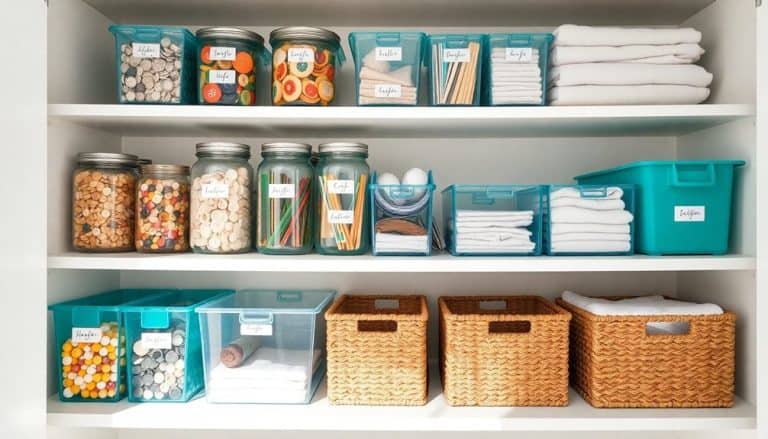This website contains affiliate links. Some products are gifted by the brand to test. As an Amazon Associate, I earn from qualifying purchases. The content on this website was created with the help of AI.
You can create a beautiful $5,000 wedding in 2024 by focusing on smart cost-cutting strategies. Start by choosing an off-peak date between January and March to save 20-30% on venue costs, or opt for a Sunday afternoon ceremony at 40-50% less than Saturday rates. Keep your guest list to 25-30 people, and embrace non-traditional venues like public parks or community centers that rent for $200-500 per day. Consider DIY decorations using thrifted items, create your own playlist instead of hiring a band, and choose a simple two-tier cake with fresh flowers. There’s plenty more you can do to stretch every dollar while maintaining an elegant celebration.
Key Takeaways
- Book a Thursday evening or Sunday afternoon ceremony to save up to 50% on venue costs compared to Saturday weddings.
- Limit guest count to 25-30 people for a $5,000 budget, as each additional guest increases costs by $150-300.
- Choose non-traditional venues like public parks or community centers, which typically rent for $200-500 per day.
- Create DIY centerpieces using thrifted mason jars and in-season flowers, while incorporating borrowed or rented decor items.
- Opt for a buffet-style reception with bulk-prepared dishes like lasagna, saving 30-40% compared to plated dinners.
Choose Off-Peak Wedding Dates

Couples can save thousands of dollars by selecting wedding dates during off-peak seasons and less popular days of the week. January through March typically offers the lowest rates, with venue costs dropping 20-30% below peak season prices. You’ll find that Thursday evening and Sunday afternoon ceremonies can cost 40-50% less than Saturday events, while Friday weddings often come with a 25% discount.
Winter months, except for December, present excellent opportunities for budget-conscious couples. Many venues offer significant incentives during these slower periods, including complimentary upgrades, extended hours, or reduced minimum guest requirements. You’ll also benefit from greater vendor availability and negotiating power during these times.
Consider booking your wedding date at least 18 months in advance to secure the best off-peak rates. While planning a winter wedding, factor in potential weather-related costs like tent heating or indoor venue fees. Morning and early afternoon ceremonies on weekdays can reveal additional savings, with some venues offering “brunch wedding” packages at half the cost of evening events. Remember to avoid holiday weekends, as these dates often command premium pricing regardless of season.
Consider Non-Traditional Venues

Beyond traditional banquet halls and hotels, non-traditional wedding venues can slash your celebration costs by 40-60%. You’ll find significant savings by exploring public parks, community centers, art galleries, historic buildings, and private estates. Many of these venues offer unique character and charm without the premium pricing of conventional wedding locations.
Consider booking a local botanical garden, which often includes natural decorations and won’t require extensive additional florals. City-owned spaces like community centers typically rent for $200-500 per day, compared to $3,000+ for traditional venues. Farms and vineyards during off-season months can offer both indoor and outdoor spaces at reduced rates.
You can transform a backyard into an intimate wedding venue by renting a tent, chairs, and tables for roughly $1,000. Public beaches often require only a permit fee of $50-200, while state parks charge entrance fees plus a small ceremony permit. Museums and libraries frequently offer after-hours rentals at competitive rates, providing built-in entertainment and distinctive photo opportunities. When booking non-traditional spaces, make certain you factor in rental equipment costs and verify if they include basics like restrooms, parking, and power sources.
Limit Your Guest List

Every additional guest increases your wedding costs by an average of $150-300, covering food, drinks, favors, and their share of venue space. To keep your wedding within a $5,000 budget, you’ll need to limit your guest list to 25-30 people maximum. Start by creating an A-list of absolute must-invite guests, including immediate family and closest friends.
Create clear criteria for your guest selections: no children except immediate family, no plus-ones unless married or in long-term relationships, and no distant relatives or casual acquaintances. Don’t feel obligated to invite coworkers or reciprocate wedding invitations from others. Remember, this is your intimate celebration.
When you’re making cuts, be consistent with your rules to avoid hurt feelings. For example, if you’re not inviting cousins, exclude all cousins, not just some. Send out your invitations early, and don’t create a B-list of backup guests. Instead, keep your numbers firm from the start. Consider having an adults-only reception to further reduce costs, and be prepared to explain your small-wedding vision to those who aren’t invited.
DIY Wedding Decorations
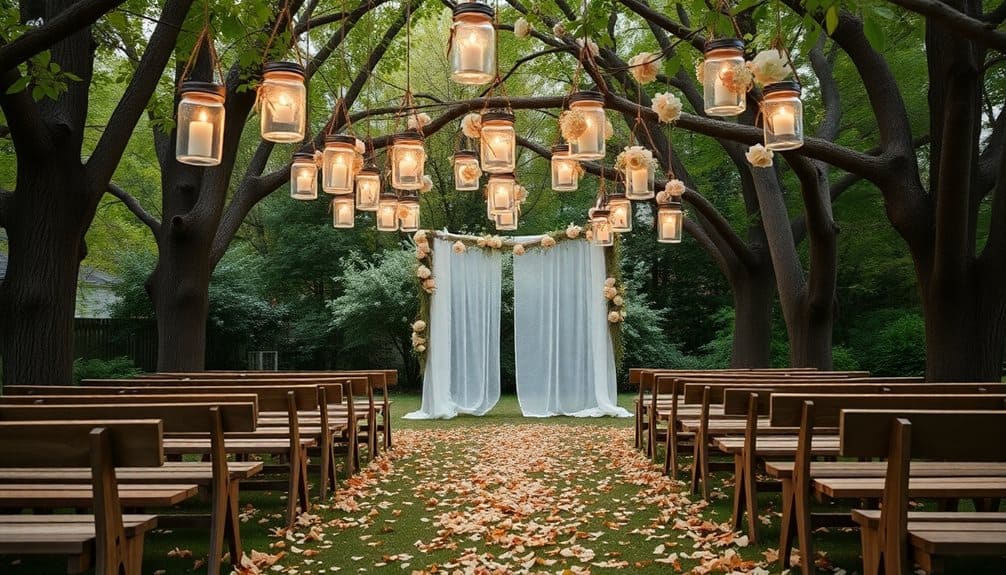
With your guest list finalized, focusing on DIY decorations can dramatically reduce your wedding expenses while adding personal charm to your celebration. Start collecting mason jars, wine bottles, and thrift store vases months before your wedding. You’ll transform these items into stunning centerpieces using spray paint, twine, and battery-operated LED lights.
Consider placing your floral centerpieces on elegant display stands to add height and visual interest to your reception tables. Create your own bouquets and floral arrangements using in-season flowers from local markets or wholesale suppliers. Mix fresh blooms with high-quality silk flowers to stretch your budget further. You can assemble these arrangements 2-3 days before the wedding and store them in a cool place.
Design your own wedding arch using PVC pipes (spray-painted to match your theme), draped with affordable tulle or fabric from discount stores. Add artificial greenery and string lights for a romantic touch. For aisle decorations, craft hanging mason jar lanterns or ribbon wands that guests can wave during your exit.
Print your own table numbers, place cards, and signage using free design tools like Canva. Mount them on frames from second-hand stores or create standing displays using wooden easels you can later sell or repurpose.
Digital Wedding Invitations

Switching over to digital wedding invitations can save hundreds on printing and postage costs while offering sophisticated design options. You’ll find numerous platforms like Paperless Post, Greenvelope, and Evite offering premium templates at a fraction of traditional invitation costs. Most digital invitation services charge between $50-150 for 100 guests, compared to $500-1,000 for printed versions.
Select a platform that includes RSVP tracking, meal preferences, and guest list management to streamline your planning process. You’ll want features like automatic guest reminders and the ability to collect additional information through custom forms. Many services also offer matching wedding websites where you can share venue details, registries, and accommodation information.
Consider sending traditional paper invitations only to older relatives or those without regular internet access. You can create a hybrid approach by ordering 15-20 printed invitations while sending digital ones to most guests. Don’t forget to choose a design that’s mobile-responsive since most guests will view it on their phones. Save the final design as a high-resolution file for your wedding album or to print a single keepsake copy.
Morning Ceremony Savings
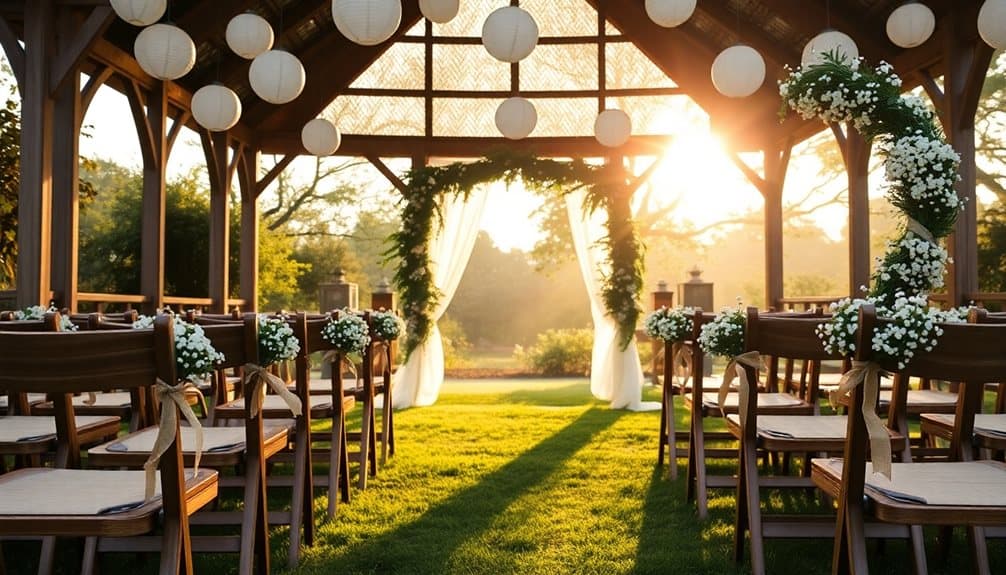
Choosing a morning ceremony can slash your wedding costs by 20-30% across multiple vendors and venues. Most venues offer significant discounts for morning events since they can book another wedding later in the day. You’ll find that photographers, DJs, and other service providers often charge less for morning time slots, as they can schedule additional events afterward.
A morning ceremony naturally leads to a brunch or lunch reception, which costs substantially less than a dinner service. You’ll save on alcohol expenses since guests typically drink less during daylight hours, and brunch cocktails like mimosas and bloody marys are cheaper than premium liquors.
- Book your venue from 9 AM to 2 PM to secure the best morning discount rates
- Serve a brunch buffet with eggs, pastries, and carved meats for 40% less than dinner pricing
- Create a mimosa and coffee bar instead of a full-service open bar
- Schedule hair and makeup to start at 5 AM to guarantee everyone’s ready for 9 AM photos
Minimize Floral Arrangements
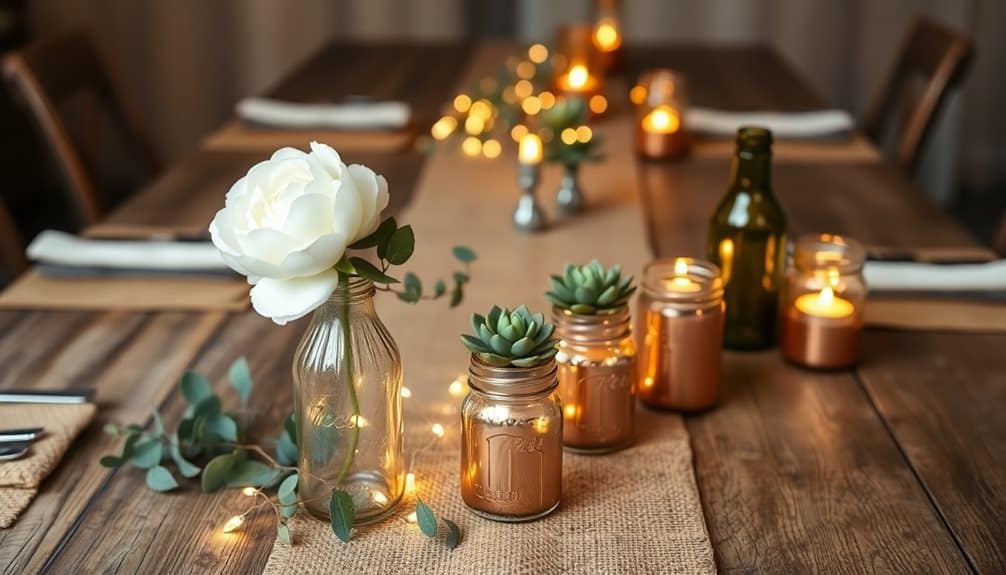
Smart floral choices can dramatically reduce your wedding expenses, as flowers typically consume 8-10% of the total budget. You’ll want to focus on seasonal blooms available locally, which can cut costs by 30-40% compared to imported varieties. For a $5000 wedding, aim to spend no more than $400-500 on all floral elements.
Consider using potted plants or greenery as centerpieces instead of cut flowers. You can rent these for $15-25 per table or purchase them for $20-30 each and resell them afterward. Limit your bouquet to 8-10 stems of in-season flowers, and opt for baby’s breath, carnations, or chrysanthemums as fillers. These cost $1-3 per stem versus $5-8 for roses or lilies.
Skip individual boutonnieres for groomsmen and use a single bloom with ribbon, saving $15-20 per person. Replace flower arrangements at the ceremony venue with LED candles and greenery garlands, which you can DIY for $50-75. If you’re crafty, create paper flowers for decorative elements – they’ll cost about $30 in materials and can be prepared months in advance.
Buffet Style Reception

When planning your reception meal, a buffet-style service can trim 30-40% off traditional plated dinner costs. You’ll save considerably on server staffing while offering guests more food choices and portion control. Focus on hearty, affordable options like pasta stations, seasonal vegetables, and protein choices that won’t break your budget.
To maximize your buffet’s efficiency and keep costs down, consider these strategic approaches:
- Set up two identical buffet lines to reduce wait times and avoid paying for extra heating equipment – you’ll need fewer warming trays when lines move quickly
- Choose filling, cost-effective dishes like lasagna, chicken marsala, or rice pilaf that can be prepared in bulk without sacrificing quality
- Opt for disposable chafing dishes instead of rental equipment, saving $25-35 per unit while maintaining a polished look
- Schedule your reception between traditional meal times (2-5 PM) to serve heavy appetizers instead of a full dinner
Don’t forget to account for dietary restrictions by clearly labeling dishes and including at least one vegetarian option. You’ll typically need about 1.5 servings per person to guarantee adequate portions while avoiding excessive waste.
Skip Traditional Wedding Favors
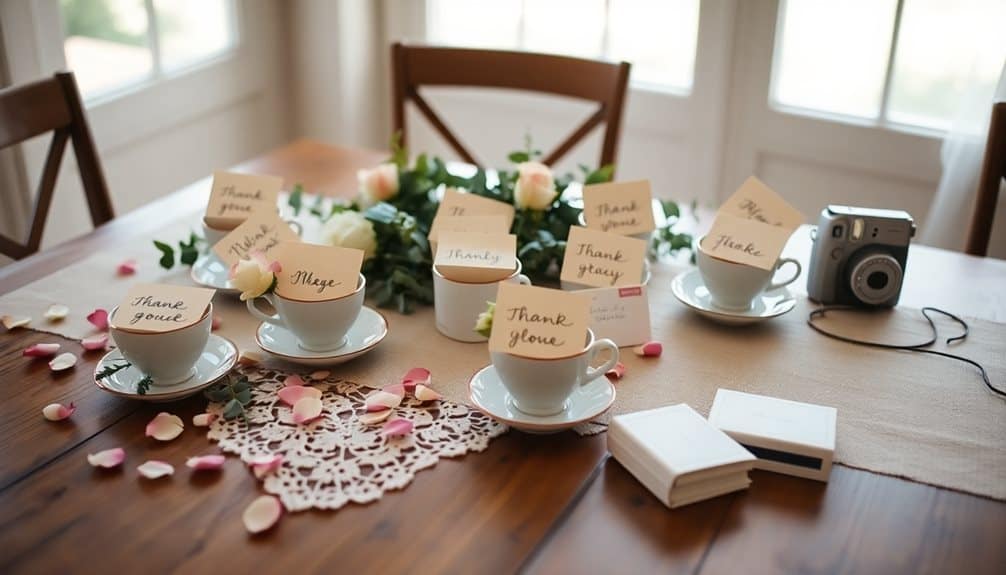
Traditional wedding favors can quickly add $300-800 to your budget without providing meaningful value to guests. Most party favors end up forgotten, discarded, or left behind at reception tables. You’ll save significant money by eliminating this non-essential tradition from your wedding plans.
If you feel strongly about offering something to guests, consider these budget-friendly alternatives that double as decorative elements. Use place cards that feature a small attached succulent ($1-2 each) or incorporate edible favors like locally sourced honey ($2-3 per jar) that can also serve as table decorations. You can even skip physical items entirely and make a charitable donation in your guests’ names, often for less than traditional favor costs.
Remember that your guests attend your wedding to celebrate your marriage, not to receive gifts. Instead of spending money on favors, redirect those funds toward elements that enhance the guest experience, such as better food options, signature drinks, or entertainment. You’ll find that most guests won’t even notice the absence of traditional favors, especially when they’re enjoying other aspects of your celebration that matter more. Consider using solar-powered lanterns as centerpieces, which can provide 6-8 hours of enchanting illumination while serving as practical decor that lasts long after the wedding.
Borrow Wedding Attire
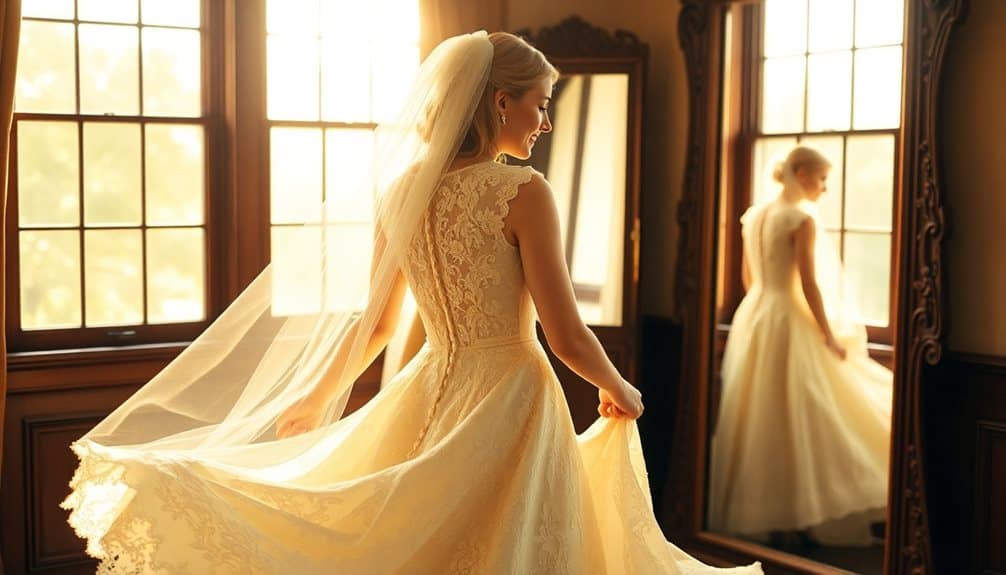
Instead of purchasing expensive wedding attire, borrowing formal wear can save you thousands on your special day. You’ll find that family members and close friends are often willing to share their preserved wedding dresses, suits, or formal accessories. With proper care and minor alterations, borrowed attire can look just as stunning as brand-new pieces while helping you stay within your $5000 budget.
When considering borrowed wedding attire, focus on these key aspects:
- Check with recently married relatives first – they’re most likely to have current styles and may feel honored to share their special garments
- Plan for alterations at least 3 months ahead – you’ll need time for multiple fittings and potential fabric matching
- Consider borrowing accessories like veils, tiaras, cufflinks, or dress shoes to complete your look
- Document the condition of borrowed items before and after use – take photos and handle with extreme care
Remember to factor in professional cleaning costs for both before and after wearing the borrowed items. Many dry cleaners offer specialized wedding dress preservation services, which you’ll want to utilize before returning the garments.
Recruit Talented Friends
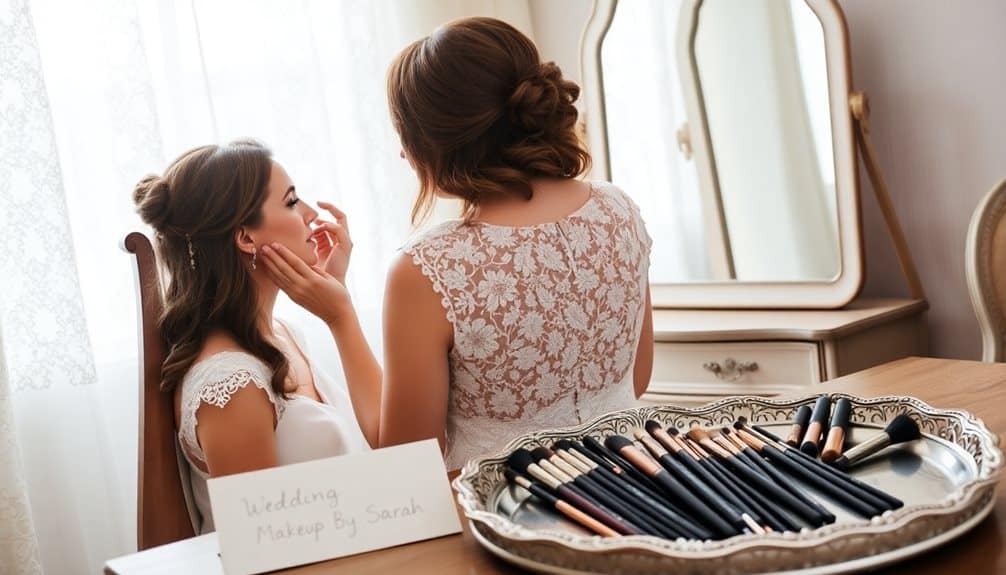
Many of your friends likely possess valuable skills that could considerably reduce your wedding costs while adding a personal touch to your celebration. Start by creating a list of friends with specific talents, such as photography, videography, musical abilities, graphic design, or floral arrangement experience.
Approach these friends early in your planning process, at least six months before the wedding date. Offer to compensate them with a meaningful gift, trade of services, or a reduced fee rather than assuming they’ll work for free. For example, a photographer friend might charge you $500 instead of their usual $2,500 rate. Your musician friend could perform during the ceremony, while your graphic designer friend could create custom invitations.
Be specific about your expectations and create simple contracts to avoid misunderstandings. Remember to provide them with timelines, detailed requirements, and backup plans. If your makeup artist friend agrees to help, schedule a trial run. For friends handling catering or baking, make sure they have proper food handling certificates and necessary equipment. Always have a backup professional’s contact information ready in case your friend encounters unexpected issues.
Backyard Wedding Setup
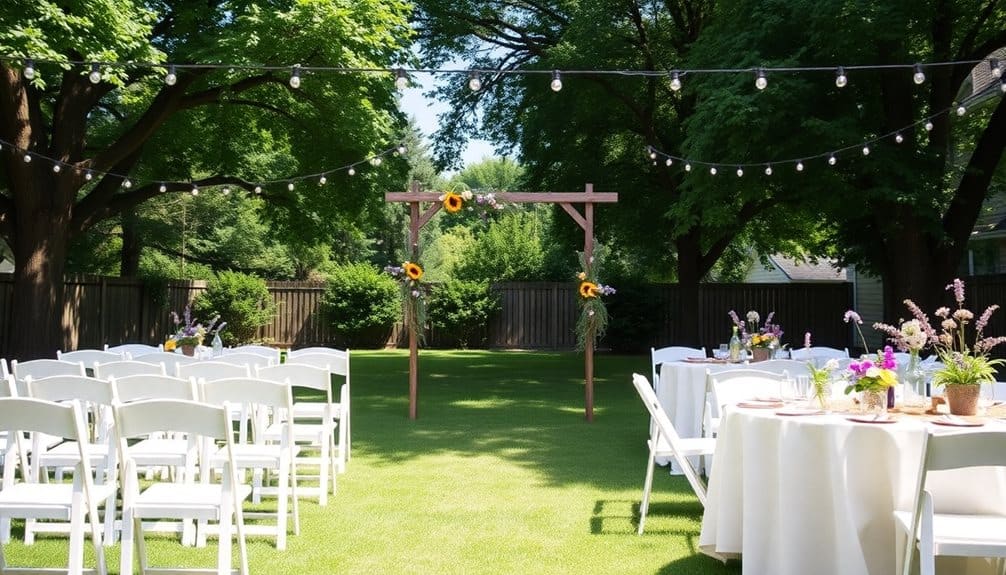
A backyard wedding venue can save you thousands while offering a deeply personal atmosphere for your special day. You’ll need to transform the space into a wedding-worthy setting by focusing on essential layout and decor elements that create maximum impact without breaking your budget.
Start by evaluating the yard’s natural features and identifying the best spots for key wedding components. You’ll want distinct areas for the ceremony, dining, dancing, and guest mingling. Consider renting basic equipment like chairs, tables, and a tent to provide comfort and weather protection for your guests.
To create an enchanting backyard wedding setup, prioritize these budget-friendly elements:
- String lights or lanterns hung between trees or poles for ambient evening lighting ($100-200)
- Portable dance floor tiles arranged on a flat surface ($300-500)
- DIY centerpieces using seasonal flowers and glass containers from dollar stores ($150-200)
- Weather-resistant aisle runner and simple arch decorated with fabric and greenery ($200-250)
Remember to check local noise ordinances, arrange for adequate bathroom facilities, and verify your home’s electrical system can handle the additional power requirements for lighting and sound equipment.
Thrift Store Decor Finds

Savvy brides can transform secondhand treasures into stunning wedding decor by exploring local thrift stores, estate sales, and flea markets. You’ll find vintage vases, brass candlesticks, antique picture frames, and decorative mirrors at a fraction of retail prices. Start collecting items 6-8 months before your wedding to guarantee you’ll have enough matching pieces.
Focus on items that need minimal alterations: clear glass containers for centerpieces, metallic items you can spray paint in your wedding colors, and fabric items like tablecloths or runners. Look for brass candleholders ($2-5 each), vintage hardcover books ($1-3 each), and mason jars (often under $1) to create cohesive tablescapes.
Don’t overlook seasonal items sold after holidays – Christmas ornaments can become wedding favors, and Valentine’s Day items work well for ceremony decor. Visit thrift stores in affluent neighborhoods on weekday mornings for the best selection. Keep a detailed inventory of your finds, including prices and intended use. Set a monthly budget of $50-75 for thrift store shopping, and always test any electrical items before purchase. Clean everything thoroughly with appropriate cleaners, and store items in labeled boxes until your wedding day.
Playlist Instead of Band

Creating your own wedding playlist can save thousands of dollars compared to hiring live musicians, while still delivering personalized entertainment for your reception. You’ll need to invest time in curating the perfect song selections and guaranteeing smooth shifts between tracks. Start building your playlist at least three months before the wedding to avoid last-minute stress.
To create a successful DIY wedding playlist, follow these essential steps:
- Rent or purchase professional-grade speakers and equipment ($200-300) rather than relying on basic portable speakers that won’t fill your venue properly.
- Download high-quality audio files (320kbps minimum) to guarantee crystal-clear sound throughout your venue – avoid streaming services that might disconnect.
- Organize your playlist into distinct segments (ceremony, cocktail hour, dinner, dancing) with appropriate energy levels and shifts for each.
- Designate a trusted friend to manage the audio equipment, handle volume adjustments, and make timing-based song changes during key moments.
Remember to test your playlist and equipment at the venue before the wedding day, and always have a backup device with your music files. Consider using professional DJ software for smoother shifts between songs.
Opt For Simple Cake
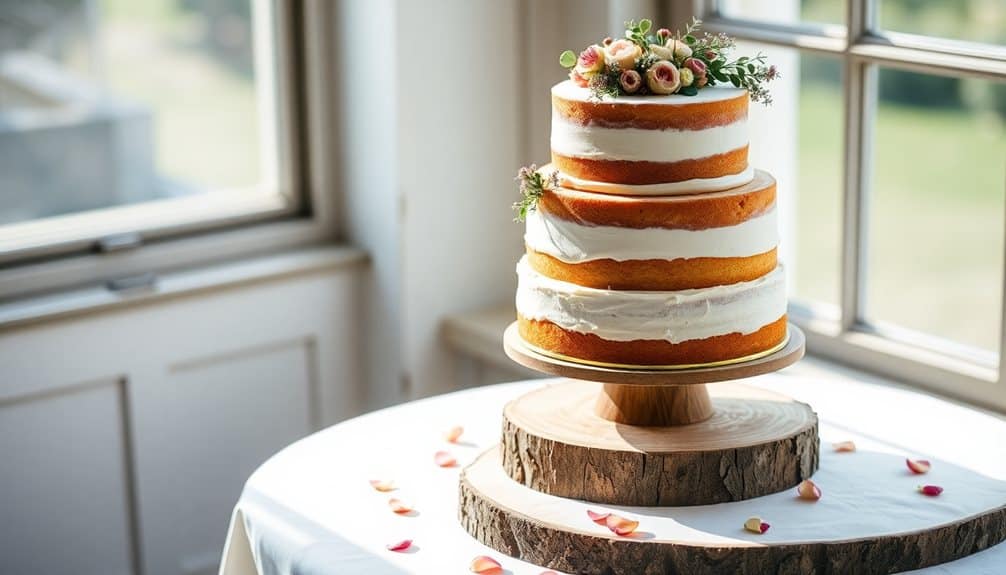
While music sets the atmosphere, your wedding cake makes a visual statement without requiring elaborate designs or excessive sugar work. You can create a stunning centerpiece by choosing a simple two-tier vanilla cake with smooth buttercream frosting, which typically costs between $200-$300, compared to $800+ for elaborate designs. Consider ordering from a local bakery rather than a specialist wedding cake shop to reduce costs further.
Fresh flowers make excellent cake decorations and can match your wedding bouquet. You’ll save $100-$150 by skipping fondant and sugar flowers in favor of real blooms. Order a smaller display cake for cutting ceremonies and photographs, then serve sheet cakes to your guests. This strategy can cut your cake budget by 40%.
Don’t feel pressured to stick with traditional wedding cake flavors. Simple combinations like vanilla-raspberry or lemon-blueberry are crowd-pleasers and cost less than exotic flavor combinations. If you’re really budget-conscious, consider cupcake towers or a dessert bar featuring homemade treats from family members. These alternatives can reduce your dessert costs to under $150 while still maintaining that special wedding day feeling.
Just as distilled water helps prevent mineral buildup in indoor fountains, using filtered water in your cake batter can enhance its taste and texture while keeping costs minimal.
Frequently Asked Questions
How Far in Advance Should I Start Planning a Wedding?
You’ll need to start planning your $5,000 wedding at least 12-18 months ahead to secure the best deals and vendor availability. Begin by creating a detailed budget breakdown, researching off-peak dates, and comparing venue prices. Use this time to DIY decorations, shop sales for attire, and negotiate with vendors. Early planning lets you track seasonal discounts and explore budget-friendly alternatives without rushing decisions.
What Insurance Coverage Do I Need for a Low-Budget Wedding?
You’ll need three essential types of insurance for your wedding: liability insurance to protect against accidents or injuries ($100-300), cancellation insurance to cover deposits if you need to postpone ($200-400), and ring insurance for your wedding bands ($50-100 annually). If you’re serving alcohol, add host liquor liability coverage. Check if your venue already includes liability coverage to avoid duplicate costs.
Which Wedding Expenses Should I Absolutely Not Cut Corners On?
You’re scanning wedding blogs when you stumble upon a horror story: a couple who skimped on photography, only to lose their memories to corrupted files. Don’t cut corners on your photographer, wedding rings, or marriage license – these elements last forever. Your venue’s safety and food quality also deserve full investment to protect guests. Finally, invest in a skilled officiant who’ll make your ceremony meaningful and legal.
Can I Negotiate Payment Plans With Wedding Vendors for Better Rates?
You can negotiate payment plans with most wedding vendors, but you’ll need to approach it strategically. Contact vendors early, be upfront about your budget, and ask if they offer installment options. Many photographers, venues, and caterers will work with structured payments spread over 6-12 months. Just get all payment terms in writing, including deadlines and late fees. Consider offering a larger deposit for a better overall rate.
What Percentage of the Budget Should Go Toward Each Expense?
Did you know that successful budget weddings typically allocate 40% to their top priority? For your $5,000 budget, you’ll want to divide it this way: venue and rentals (30% or $1,500), food and beverages (25% or $1,250), attire and accessories (15% or $750), photography (15% or $750), decorations (8% or $400), and miscellaneous expenses like invitations, music, and favors (7% or $350).




